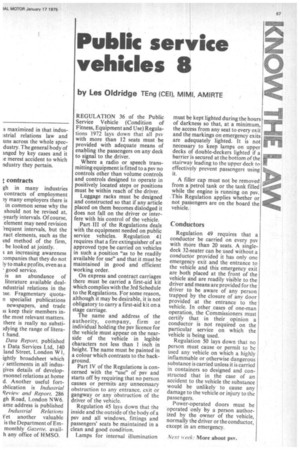Public service vehicles 8
Page 69

If you've noticed an error in this article please click here to report it so we can fix it.
by Les Oldndge TEng (CEI) MIMI AMIRTE REGULATION 36 of the Public Service Vehicle (Condition of Fitness, Equipment and Use) Regulations 1972 lays down that all psv with more than 12 seats must be provided with adequate means of enabling the passengers on any deck to signal to the driver.
Where a radio or speech transmitting equipment is fitted to a psv no controls other than volume controls and controls designed to operate in positively located steps or positions must be within reach of the driver.
Luggage racks must be designed and constructed so that if any article placed on them becomes dislodged it does not fall on the driver or interfere with his control of the vehicle.
Part III of the Regulations deals with the equipment needed on public service vehicles. Regulation 41 requires that a fire extinguisher of an approved type be carried on vehicles in such a position "as to be readily available for use" and that it must be maintained in good and efficient working order.
On express and contract carriages there must be carried a first-aid kit which complies with the 3rd Schedule to the Regulations. For some reason, although it may be desirable, it is not obligatory to carry a first-aid kit on a stage carriage.
The name and address of the authority, company, firm or individual holding the psv licence for the vehicle must appear on the nearside of the vehicle in legible characters not less than 1 inch in height. The name must be painted in a colour which contrasts to the background.
Part IV of the Regulations is concerned with the "use" of psv and starts off by requiring that no person causes or permits• any unnecessary obstruction to any entrance, exit or gangway or any obstruction of the driver of the vehicle.
Regulation 45 lays down that the inside and the outside of the body of a psv and all windows, fittings and passengers' seats be maintained in a clean and good condition.
Lamps for internal illumination must be kept lighted during the hours of darkness so that, at a minimum, the access from any seat to every exit and the markings on emergency exits are adequately lighted. It is not necessary to keep lamps on upper decks of double-deckers lighted if a barrier is secured at the bottom of the stairway leading to the upper deck to effectively prevent passengers using it.
A filler cap must not be removed from a petrol tank or the tank filled while the engine is running on psv, _This Regulation applies whether or not passengers are on the board the vehicle.
Conductors
Regulation 49 requires that a conductor be carried on every psv with More than 20 seats. A singledeck 32-seater can be used without a conductor provided it has only one emergency exit and the entrance to the vehicle and this emergency exit are both placed at the front of the vehicle and are readily visible to the driver and means are provided for the driver to be aware of any person trapped by the closure of any door provided at the entrance to the vehicle. In other , cases of one-man operation, the Commissioners must certify that in their opinion a conductor is not required on the particular service on which the vehicle is being used.
Regulation 50 lays down that no person must cause or permit to be used any vehicle on which a highly inflammable or otherwise dangerous substance is carried unless it is carried in containers so designed and constructed that in the case of an accident to the vehicle the substance would be unlikely to cause any damage to the vehicle or injury to the passengers.
Power-operated doors must be operated only by a person authorized by the owner of the vehicle, normally the driver or the conductor, except in an emergency.
Next week: More about psv.
























































































































